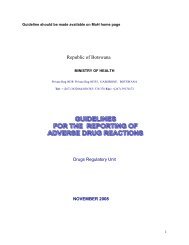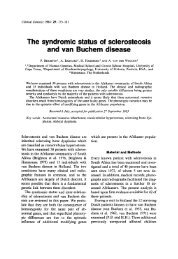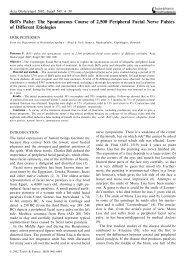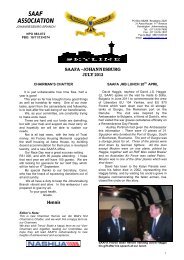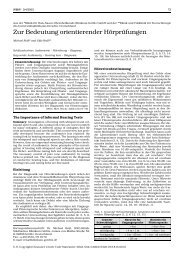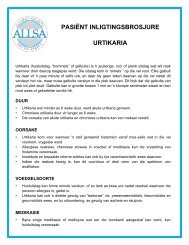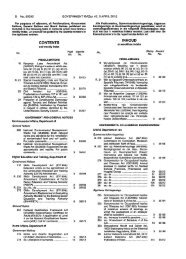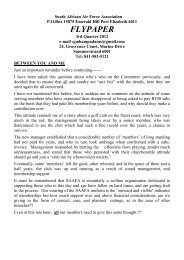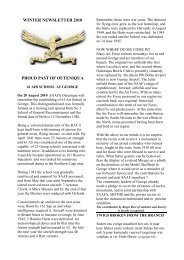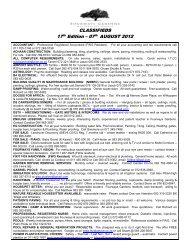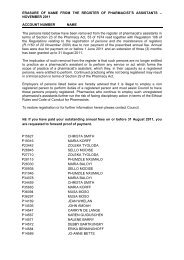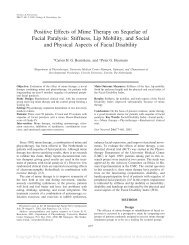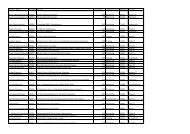SAAF ASSOCIATION
SAAF ASSOCIATION
SAAF ASSOCIATION
You also want an ePaper? Increase the reach of your titles
YUMPU automatically turns print PDFs into web optimized ePapers that Google loves.
<strong>SAAF</strong>A JHB LUNCH 26 TH OCTOBER<br />
Wing Commander Clive Mitchell’s speech at<br />
our lunch – it was so historically interesting<br />
that we have reproduced it as he delivered it<br />
for those who weren’t at the lunch to read:<br />
“ Chairman, ladies and gentlemen, it is a great<br />
privilege for Terry and me to be here this<br />
afternoon and I am just sorry that it has taken<br />
almost 2 ½ years for us to be able to attend one<br />
of your lunches. Havi ng accepted the invitation a<br />
couple of months ago, I was slightly surprised<br />
that Carol had not asked me to ‘say a few words’.<br />
However, that was put right on Tuesday when<br />
she rang me to say that the planned speaker had<br />
had to cancel and could I step in. 3 days notice<br />
is a luxury as the RAFOC usually ask me to step<br />
in with just a few hours to conjure something up.<br />
This afternoon I thought I would cover the<br />
formative years of the world’s 2 oldest<br />
independent air forces before moving on to<br />
current links between the <strong>SAAF</strong> and the RAF.<br />
Given the relatively short notice that I had, I<br />
intend to follow the 3 Bs of public speaking; be<br />
funny, be brief and be gone. Hopefully, I’ll hit at<br />
least 2 of the 3 anyway!<br />
Military aviation in Britain began in 1878<br />
when the Royal Engineers formed a Balloon unit.<br />
However, it was not until 1907 that a powered<br />
army airship became operational and the first Air<br />
Battalion was established in 1911. At first<br />
progress was slow and by 1912 the Air Battalion<br />
only had eleven qualified pilots compared to 263<br />
in the French Army Air Service. Nevertheless, in<br />
Apr 1912 the Royal Flying Corps was formed as<br />
the military began to recognise the potential for<br />
aircraft as observation platforms. It was in this<br />
role that the RFC went to war in 1914 to<br />
undertake reconnaissance and artillery<br />
observation. Shortly before the war a separate<br />
Naval Air Service (RNAS) was established<br />
splitting off from the RFC, though they retained a<br />
combined central flying school. At the<br />
commencement of the First World War Britain<br />
had only 113 aircraft in military service compared<br />
to 160 in the French Aviation Service and 246 in<br />
the German Air Service. The RFC had<br />
experimented before the war with the arming of<br />
aircraft but the means of doing so remained<br />
awkward - because of the need to avoid the<br />
propeller arc and other obstructions such as<br />
wings and struts. In the early part of the war the<br />
risk of injury to aircrew was therefore largely<br />
through accidents. As air armament developed<br />
the dangers to aircrew increased markedly and<br />
by the end of the war the loss rate was 1 in 4<br />
killed, a similar figure to that of the infantry losses<br />
in the trenches. In the final days of the RFC, over<br />
1200 aircraft were deployed in France and<br />
available to meet the German offensive of 21<br />
March 1918 with the support of RNAS squadrons.<br />
From 1 April these forces combined to form the<br />
Royal Air Force as an independent armed<br />
service. From small beginnings the air services<br />
had grown and by the end of the war the RAF<br />
had a total of 290,000 men, 99 Squadrons and<br />
1800 aircraft in France and a further 34<br />
squadrons overseas. In addition there were 55<br />
Home Establishment squadrons and 199 training<br />
squadrons, with a total inventory of some 22,544<br />
aircraft and 385 000 personnel. As Mary Hopkins<br />
would say “those were the days my friends”! For<br />
those of you that are interested, today the RAF<br />
has 827 aircraft and is downsizing to 33, 500<br />
personnel. Nevertheless, that still makes us the<br />
largest air force in the EU and we retain some<br />
potent capabilities. You will all be aware of the<br />
impact that the Smuts Reports of 1917 had on<br />
the formation of the RAF, and in fact on the<br />
creation of independent air forces world-wide,<br />
and I do not intend to dwell any further on those.<br />
Instead, I will now focus on the parallel<br />
development of the <strong>SAAF</strong>. Although military<br />
aviation was still in its infancy at the time that the<br />
Union Defence Force was formed, the South<br />
African Defence Act (1912) made provision for<br />
the establishment of the South African Aviation<br />
Corps as part of the Active Citizen Force. In<br />
August 1912, the Commandant-General of the<br />
Citizen Force, Brig Gen Beyers, was sent to<br />
Europe by General Smuts to observe and report<br />
on the use of aircraft in military operations.<br />
Beyers was so impressed by what he saw that<br />
when he returned to the Union he strongly<br />
recommended setting up a school of aviation.<br />
The Government subsequently contracted Mr<br />
Cecil Compton Paterson to provide flying training<br />
to a select group of ten aviators at his flying<br />
school near Kimberley. In April 1914, six of the<br />
pupils were appointed as probationary lieutenants<br />
in the Active Citizen Force and sent to England to<br />
undergo further training at the Central Flying<br />
School at Upavon where five of them eventually<br />
qualified. On the outbreak of war in August 1914,<br />
the South Africans were granted permission to<br />
join the newly formed Royal Flying Corps and<br />
they were to participate in the first aerial<br />
reconnaissance and artillery spotting missions<br />
over France during the closing months of 1914.<br />
Best known amongst the South African pilots in<br />
the RFC in WW1 was Capt Andrew W.<br />
Beauchamp-Proctor the first South African Pilot<br />
to win the Victoria Cross and who also won the<br />
DSO, MC and Bar, DFC, Croix De Guerre and<br />
Legion of Honour. Despite the strict economies<br />
and retrenchments to which the Union Defence<br />
Force was subject in the immediate post-war<br />
years, 1 February 1920 saw the establishment of<br />
the South African Air Force with Col Pierre van<br />
Ryneveld appointed Director Air Services. The<br />
establishment of the South African Air Force was<br />
greatly facilitated by what came to be known as<br />
the “Imperial Gift”. Essentially, the British<br />
Government gave the South African Air Force<br />
113 aircraft (amazingly, the same number of<br />
8



